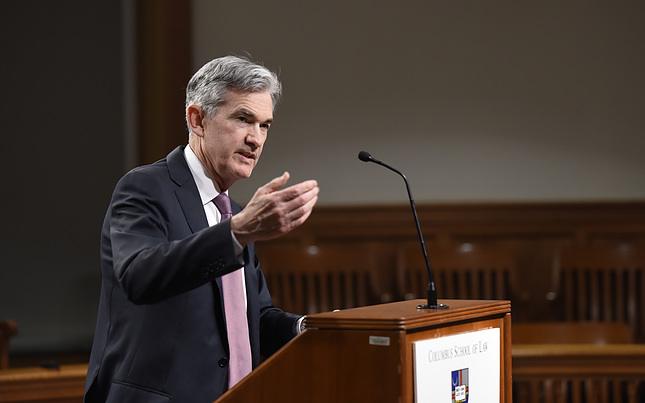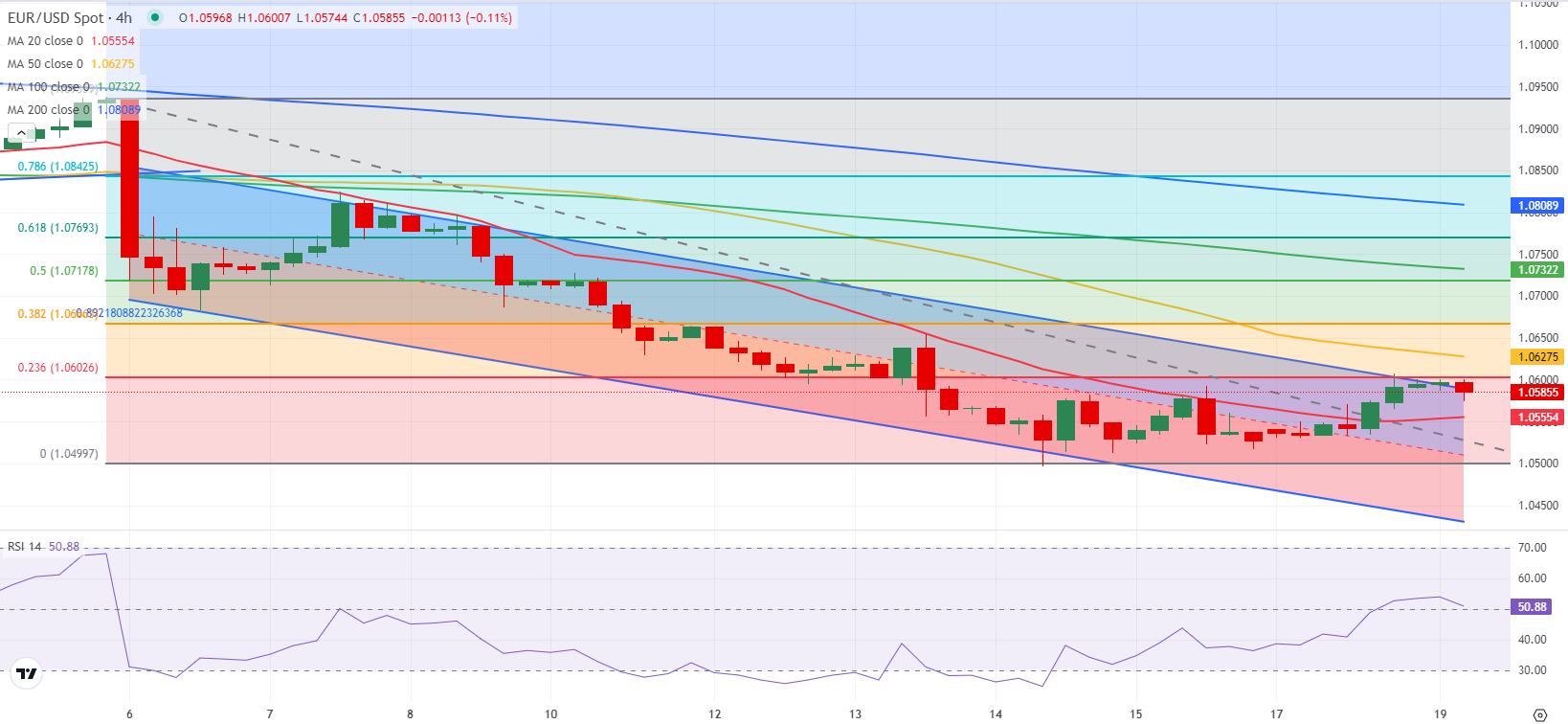- EUR/USD edges lower after closing in positive territory on Monday.
- Technical buyers could show interest once the pair stabilizes above 1.0600.
- Risk perception could impact the pair's action in the absence of high-tier data releases.
EUR/USD started the week on a firm footing and climbed above 1.0600 on Monday. In the European morning on Tuesday, the pair struggles to preserve its recovery momentum and trades below this level.
Euro PRICE This week
The table below shows the percentage change of Euro (EUR) against listed major currencies this week. Euro was the strongest against the Japanese Yen.
| USD | EUR | GBP | JPY | CAD | AUD | NZD | CHF | |
|---|---|---|---|---|---|---|---|---|
| USD | -0.42% | -0.42% | 0.23% | -0.50% | -0.80% | -0.51% | -0.48% | |
| EUR | 0.42% | 0.17% | 0.77% | 0.04% | -0.23% | 0.03% | 0.05% | |
| GBP | 0.42% | -0.17% | 0.61% | -0.14% | -0.41% | -0.14% | -0.13% | |
| JPY | -0.23% | -0.77% | -0.61% | -0.75% | -0.97% | -0.69% | -0.65% | |
| CAD | 0.50% | -0.04% | 0.14% | 0.75% | -0.27% | -0.01% | 0.02% | |
| AUD | 0.80% | 0.23% | 0.41% | 0.97% | 0.27% | 0.26% | 0.29% | |
| NZD | 0.51% | -0.03% | 0.14% | 0.69% | 0.00% | -0.26% | 0.02% | |
| CHF | 0.48% | -0.05% | 0.13% | 0.65% | -0.02% | -0.29% | -0.02% |
The heat map shows percentage changes of major currencies against each other. The base currency is picked from the left column, while the quote currency is picked from the top row. For example, if you pick the Euro from the left column and move along the horizontal line to the US Dollar, the percentage change displayed in the box will represent EUR (base)/USD (quote).
The US Dollar (USD) came under selling pressure in the American trading hours on Monday and helped EUR/USD push higher. Falling US Treasury bond yields seemingly weighed on the USD, while the cautious market mood helped the currency limit its losses, capping the pair's upside.
In the meantime, European Central Bank (ECB) Governing Council member and Central Bank of Ireland Governor Gabriel Makhlouf said on Monday that overwhelming evidence would be needed to consider a 50 basis points rate cut in December. "I believe in a cautious and prudent approach, believe the policy is working," he added, further supporting the Euro.
Early Tuesday, US stock index futures trade marginally higher on the day. A bullish opening in Wall Street could make it difficult for the USD to find demand and open the door for an extended recovery in EUR/USD later in the day.
Eurostat will publish revisions to the October Harmonized Index of Consumer Prices (HICP) inflation data in the European session. The US economic calendar will offer Housing Starts and Building Permits figures for October. These data are unlikely to trigger a noticeable market reaction, allowing the risk perception to continue to influence EUR/USD's action.
EUR/USD Technical Analysis
The upper limit of the descending regression channel and the Fibonacci 23.6% retracement of the two-week-old downtrend form important resistance at 1.0600. In case EUR/USD rises above this level and starts using it as support, the 20-period Simple Moving Average (SMA) on the 4-hour chart could act as interim resistance at 1.0630 ahead of 1.0670 (Fibonacci 38.2% retracement) and 1.0720 (Fibonacci 50% retracement).
On the downside, 1.0550 (20-period SMA) aligns as immediate support before 1.0500 (mid-point of the descending channel) and 1.0430 (lower limit of the descending channel).
Euro FAQs
The Euro is the currency for the 19 European Union countries that belong to the Eurozone. It is the second most heavily traded currency in the world behind the US Dollar. In 2022, it accounted for 31% of all foreign exchange transactions, with an average daily turnover of over $2.2 trillion a day. EUR/USD is the most heavily traded currency pair in the world, accounting for an estimated 30% off all transactions, followed by EUR/JPY (4%), EUR/GBP (3%) and EUR/AUD (2%).
The European Central Bank (ECB) in Frankfurt, Germany, is the reserve bank for the Eurozone. The ECB sets interest rates and manages monetary policy. The ECB’s primary mandate is to maintain price stability, which means either controlling inflation or stimulating growth. Its primary tool is the raising or lowering of interest rates. Relatively high interest rates – or the expectation of higher rates – will usually benefit the Euro and vice versa. The ECB Governing Council makes monetary policy decisions at meetings held eight times a year. Decisions are made by heads of the Eurozone national banks and six permanent members, including the President of the ECB, Christine Lagarde.
Eurozone inflation data, measured by the Harmonized Index of Consumer Prices (HICP), is an important econometric for the Euro. If inflation rises more than expected, especially if above the ECB’s 2% target, it obliges the ECB to raise interest rates to bring it back under control. Relatively high interest rates compared to its counterparts will usually benefit the Euro, as it makes the region more attractive as a place for global investors to park their money.
Data releases gauge the health of the economy and can impact on the Euro. Indicators such as GDP, Manufacturing and Services PMIs, employment, and consumer sentiment surveys can all influence the direction of the single currency. A strong economy is good for the Euro. Not only does it attract more foreign investment but it may encourage the ECB to put up interest rates, which will directly strengthen the Euro. Otherwise, if economic data is weak, the Euro is likely to fall. Economic data for the four largest economies in the euro area (Germany, France, Italy and Spain) are especially significant, as they account for 75% of the Eurozone’s economy.
Another significant data release for the Euro is the Trade Balance. This indicator measures the difference between what a country earns from its exports and what it spends on imports over a given period. If a country produces highly sought after exports then its currency will gain in value purely from the extra demand created from foreign buyers seeking to purchase these goods. Therefore, a positive net Trade Balance strengthens a currency and vice versa for a negative balance.
Information on these pages contains forward-looking statements that involve risks and uncertainties. Markets and instruments profiled on this page are for informational purposes only and should not in any way come across as a recommendation to buy or sell in these assets. You should do your own thorough research before making any investment decisions. FXStreet does not in any way guarantee that this information is free from mistakes, errors, or material misstatements. It also does not guarantee that this information is of a timely nature. Investing in Open Markets involves a great deal of risk, including the loss of all or a portion of your investment, as well as emotional distress. All risks, losses and costs associated with investing, including total loss of principal, are your responsibility. The views and opinions expressed in this article are those of the authors and do not necessarily reflect the official policy or position of FXStreet nor its advertisers. The author will not be held responsible for information that is found at the end of links posted on this page.
If not otherwise explicitly mentioned in the body of the article, at the time of writing, the author has no position in any stock mentioned in this article and no business relationship with any company mentioned. The author has not received compensation for writing this article, other than from FXStreet.
FXStreet and the author do not provide personalized recommendations. The author makes no representations as to the accuracy, completeness, or suitability of this information. FXStreet and the author will not be liable for any errors, omissions or any losses, injuries or damages arising from this information and its display or use. Errors and omissions excepted.
The author and FXStreet are not registered investment advisors and nothing in this article is intended to be investment advice.
Recommended Content
Editors’ Picks

GBP/USD slides toward 1.2600 ahead of Bailey's testimony
GBP/USD is seeing a fresh selling wave, approaching 1.2600 n Tuesday. The latest leg down in the pair could be linked to escalating Russia-Ukraine geopolitical tesnions, which lift the safe-haven US Dollar. BoE Governor Bailey's tesitmony awaited.

EUR/USD remains heavy near 1.0550 amid escalating Russia-Ukraine conflict
EUR/USD stays under heavy selling pressure near 1.0550 in Tuesday's European trading. The US Dollar finds fresh haven demand on escalating goeopolitical tensions amid reports that Kremlin is threatening a nuclear response amid Ukraine's use of Western missiles against Russia.

Gold price extends recovery gains toward $2,640 as geopolitical risks intensify
Gold price refreshes one-week highs, nearing $2,640 as risk-aversion grips markets amid intensifying geopolitical tensions between Russia and Ukraine. Investors are scurring toward safe-havens such as the US Dollar, Gold price for some cover.

Canada CPI expected to rise 1.9% in October, bolstering BoC to further ease policy
The Canadian Consumer Price Index is seen ticking higher by 1.9% YoY in October. The Bank of Canada has reduced its policy rate by 125 basis points so far this year. The Canadian Dollar navigates multi-year lows against its American counterpart.

The week ahead: Powell stumps the US stock rally as Bitcoin surges, as we wait Nvidia earnings, UK CPI
The mood music is shifting for the Trump trade. Stocks fell sharply at the end of last week, led by big tech. The S&P 500 was down by more than 2% last week, its weakest performance in 2 months, while the Nasdaq was lower by 3%. The market has now given back half of the post-Trump election win gains.

Best Forex Brokers with Low Spreads
VERIFIED Low spreads are crucial for reducing trading costs. Explore top Forex brokers offering competitive spreads and high leverage. Compare options for EUR/USD, GBP/USD, USD/JPY, and Gold.
